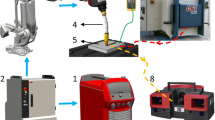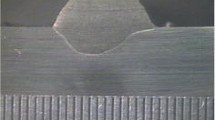Abstract
Cold metal transfer (CMT) welding is a sophisticated version of fusion welding process available with advanced features incorporated in it. During the process of joining metallic parts with CMT, the bead shape and size have significant effects on the weld quality. Typically, bead geometry is characterized by the three important parameters namely weld width, weld depth and reinforcement height. For rapid and intelligent welding, it is imperative to monitor the bead shape and size during the process. However, the measurement system of three parameters is often time consuming and complex. In this paper, an attempt is made to reduce the computational time of artificial intelligence models that are used for intelligent welding processes. Bead coefficient is modelled as an alternative for bead geometry properties. Computationally efficient artificial neural network models are developed for examining the feasibility of bead coefficient over bead geometry properties with and without online-temperature measurements. The predicted results of both forward and reverse neural network models are in good coherence with the experimental values. The outcome of this study is expected to provide a detailed understanding of effects of process parameters on bead geometry and bead coefficient, which facilitates online monitoring of welding processes.






Similar content being viewed by others
References
Huot, P. (2015). The basics of weld and process monitoring. Quality, 6NDT
Talalaev R, Veinthal R, Laansoo A, Sarkans M (2012) Cold metal transfer (CMT) welding of thin sheet metal products. Estonian J Eng 18(3):243
Khan, M. I. (2007). Welding science and technology. New Age International
Nagesh DS, Datta GL (2002) Prediction of weld bead geometry and penetration in shielded metal-arc welding using artificial neural networks. J Mater Process Technol 123(2):303–312
Kanti KM, Rao PS (2008) Prediction of bead geometry in pulsed GMA welding using back propagation neural network. J Mater Process Technol 200(1–3):300–305
Kumar NP, Devarajan PK, Vendan SA, Shanmugam N (2017) Prediction of bead geometry in cold metal transfer welding using back propagation neural network. Int J Adv Manuf Technol 93(1–4):385–392
Raveendra J, Parmar RS (1987) Mathematical models to predict weld bead geometry for flux cord arc welding. Metal Construction 19(1):31R–35R
Chandel RS (1988) Mathematical modelling of gas metal arc weld features. In: Proceedings of the fourth international conference on modeling of casting and welding processes, pp 109–120
Zhang W, Kim CH, DebRoy T (2004) Heat and fluid flow in complex joints during gas metal arc welding—part I: numerical model of fillet welding. J Appl Phys 95(9):5210–5219
Fan HG, Kovacevic R (2004) A unified model of transport phenomena in gas metal arc welding including electrode, arc plasma and molten pool. J Phys D Appl Phys 37(18):2531
Di L, Chandel RS, Srikanthan T (1999) Static modeling of GMAW process using artificial neural networks. Mater Manuf Process 14(1):13–35
Gunaraj V, Murugan N (2000) Prediction and optimization of weld bead volume for the submerged arc process—part 1. Weld J 79(10):286s–294s
Datta S, Bandyopadhyay A, Pal PK (2008) Grey-based Taguchi method for optimization of bead geometry in submerged arc bead-on-plate welding. Int J Adv Manuf Technol 39(11–12):1136–1143
Tarng YS, Yang WH (1998) Optimisation of the weld bead geometry in gas tungsten arc welding by the Taguchi method. Int J Adv Manuf Technol 14(8):549–554
Gunaraj V, Murugan N (1999) Application of response surface methodology for predicting weld bead quality in submerged arc welding of pipes. J Mater Process Technol 88(1–3):266–275
Huang SH, Li D, Song YL (1994) Weld quality control by neural network. Weld World 34:359–363
Cook GE, Barnett RJ, Andersen K, Strauss AM (1995) Weld modeling and control using artificial neural networks. IEEE Trans Ind Appl 31(6):1484–1491
Golmezerji, R., Moghaddam, M. A., & Kolahan, F. (2017). Simultaneous optimization of joint edge geometry and process parameters in gas metal arc welding using integrated ANN-PSO approach
Shah, J., Patel, G., & Makwana, J. (2017). A review on optimization and prediction of MIG welding process parameters using ANN
Casalino G, Facchini F, Mortello M, Mummolo G (2016) ANN modelling to optimize manufacturing processes: the case of laser welding. IFAC-PapersOnLine 49(12):378–383
Pankaj A, Rishi OP, Sharma KC (2015) Literature review on soft computing optimization techniques in MIG/MAG welding parameters. Int J Comput Sci Eng Technol 3:26–31
Senthil Kumar R, Parmer RS (1986) Weld bead geometry prediction for pulse MIG welding. In: Proceedings of an International Conference on Trends in Welding Technology, USA, May 18–22, pp 647–652
DuPont JN, Marder AR (1996) Dilution in single pass arc welds. Metall Mater Trans B Process Metall Mater Process Sci 27(3):481–489
Hunt AC, Kluken AO, Edwards GR (1994) Heat input and dilution effects in microalloyed steel weld metals. Welding J New York 73:9
Balasubramanian V, Lakshminarayanan AK, Varahamoorthy R, Babu S (2009) Application of response surface methodolody to prediction of dilution in plasma transferred arc hardfacing of stainless steel on carbon steel. J Iron Steel Res Int 16(1):44–53
Lakshminarayanan AK, Balasubramanian V, Varahamoorthy R, Babu S (2008) Predicting the dilution of plasma transferred arc hardfacing of stellite on carbon steel using response surface methodology. Met Mater Int 14(6):779
Aghakhani M, Jalilian MM, Karami A (2012) Prediction of weld bead dilution in GMAW process using fuzzy logic. Appl Mech Mater 110:3171–3175 Trans tech publications ltd
Francis JA, Bednarz B, Bee JV (2002) Prediction of steady state dilution in multipass hardfacing overlays deposited by self shielded flux cored arc welding. Sci Technol Weld Join 7(2):95–101
Nweze S, Achebo J (2019) The use of fuzzy logic in predicting percentage (%) dilution of weld during Tig welding process. Mater Sci Appl 10(5):406–422
Sailender M, Suresh R, Reddy GC, Venkatesh S (2020) Prediction and comparison of the dilution and heat affected zone in submerged arc welding (SAW) of low carbon alloy steel joints. Measurement 150:107084
Chan B, Pacey J, Bibby M (1999) Modelling gas metal arc weld geometry using artificial neural network technology. Can Metall Q 38(1):43–51
Author information
Authors and Affiliations
Corresponding author
Ethics declarations
Conflict of Interest
On behalf of all authors, the corresponding author states that there is no conflict of interest.
Additional information
Publisher’s Note
Springer Nature remains neutral with regard to jurisdictional claims in published maps and institutional affiliations.
Rights and permissions
About this article
Cite this article
Nalajam, P., Varadarajan, R. Experimental and Theoretical Investigations on Cold Metal Transfer Welds Using Neural Networks: A Computational Model of Weld Geometry. Exp Tech 45, 705–720 (2021). https://doi.org/10.1007/s40799-021-00451-7
Received:
Accepted:
Published:
Issue Date:
DOI: https://doi.org/10.1007/s40799-021-00451-7




